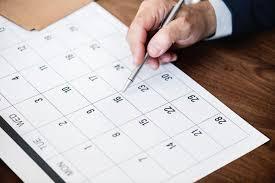10 Common Mistakes You Make When Setting Deadlines
Curated from: lifehack.org
Ideas, facts & insights covering these topics:
10 ideas
·3.8K reads
7
Explore the World's Best Ideas
Join today and uncover 100+ curated journeys from 50+ topics. Unlock access to our mobile app with extensive features.
Writing down the deadline
It is important to write down your deadlines on a calendar that you can see on a daily basis. Review your calendar each day to ensure that you do not miss any of them.
294
726 reads
Failing to research the options
If you have a deadline, research your options ahead of time before finalizing that deadline. It may take you longer to complete a project than initially anticipated.
205
419 reads
Falling prey to lack of motivation
Procrastination is often due to the lack of motivation to complete the project.
Offer yourself a reward for working on the project consistently or for when you finish the project.
259
455 reads
Setting unrealistic deadlines
Set deadlines that are realistic so that you do not feel pressured to rush. Rushing is not a good way to accomplish any task successfully.
211
362 reads
Too many deadlines
... can leave you stressed out beyond your max.
Create achievable deadlines. If you've got too many deadlines, either choose a different deadline for some tasks or see if you can delegate them.
207
319 reads
Too far into the future
If your deadline is set too far in the future, you might not really find the motivation to work consistently on meeting that deadline.
Instead, break that deadline down into smaller tasks.
249
363 reads
Lack of steps toward the deadline
Take your project and break it into smaller steps. Mark each deadline until the final project is done.
Tacking projects in bite-size bits is much more attainable and keeps your momentum going.
228
309 reads
You just need patience
Sometimes we set an unmanageable deadline on something that really just needs time and some consistency. For example, trying to lose 20 pounds in a month might not be feasible.
205
318 reads
Not understanding what is involved
Take a few days to consider what you want to accomplish within your deadline.
You may forget something important if you just rush into setting that deadline.
191
289 reads
Mimicking others
If you set the same deadlines that worked for others, you could be setting yourself up for failure.
Be confident that you can set your own deadlines that will work for you.
192
241 reads
IDEAS CURATED BY
Zachary 's ideas are part of this journey:
Learn more about personaldevelopment with this collection
How to prioritize and simplify your life
The importance of rest and relaxation
The benefits of slowing down
Related collections
Similar ideas
4 ideas
4 common but harmful myths about how your brain works
fastcompany.com
8 ideas
Habits of Super Learners
medium.com
7 ideas
Read & Learn
20x Faster
without
deepstash
with
deepstash
with
deepstash
Personalized microlearning
—
100+ Learning Journeys
—
Access to 200,000+ ideas
—
Access to the mobile app
—
Unlimited idea saving
—
—
Unlimited history
—
—
Unlimited listening to ideas
—
—
Downloading & offline access
—
—
Supercharge your mind with one idea per day
Enter your email and spend 1 minute every day to learn something new.
I agree to receive email updates



